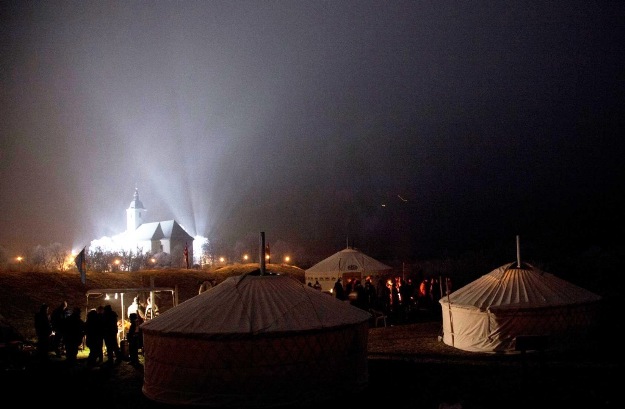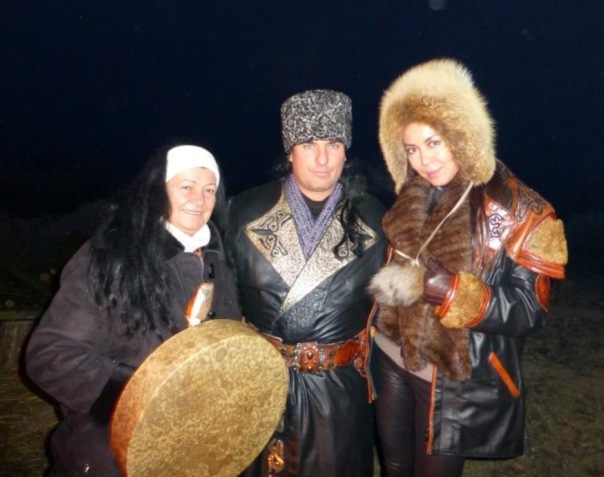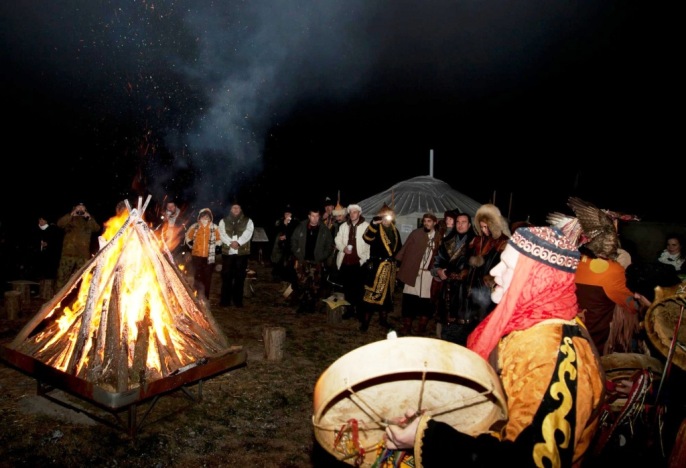Just recently the attention of the entire world was captivated by the longest night of the year - the night of 21st of December. Prediction of "the end of the world" turned out to be a myth. However this date is considered to be an astronomical New Year, and there is a country where till this day it is celebrated as an ethnic Karacsun holiday. Our compatriot, and a founder of "KAZAKHSTAN: MONTAGE OF CINEMAS" festival Gaukhar Noortas became a witness of this amazing Hungarian holiday.

- Happy 2012 for me ended with the most remarkable and captivating journey of my life, - Gaukhar Noortas told us. - I was invited to Hungary for a celebration of the “Karachun” (in Hungarian “Karácsun”) holiday, and I went expecting to find a Christian European nation. So, it came as a complete surprise for me to discover the Tengri culture there. I knew that the trip would be informative, but what I experienced truly amazed me. I felt at home, native amongst people I barely knew. From the yurts (traditional tent houses), patterns, clothing, and unbelievable hospitality to the sound of their language - everything was so familiar, so Turkic! For the first time in my life, I saw real shamans, observed their rituals, and heard their singing.
I will begin by saying that Hungarians do not refer to themselves as such; they call themselves Magyars, and their country Magyar Ország (“homeland of the Magyars”).
The word “Tengri” - or “Tenger” - can be translated as “sea” or “limitless.” In this culture, nature is God, while the object of honor is the memory of one's ancestors. Magyars have preserved this culture as their primary one. Grand Prince Árpád (c. 840-907) conquered Central Europe and settled in the Carpathian Basin. The seven tribes under his command together formed one nation, united by a blood contract. They all belonged to Tengri culture. Catholicism, brought into the country much later by a descendant of Grand Prince Árpád, Saint Stephen I, was necessary for the Magyars to strengthen the position of Hungary in Christian Europe. At the same time, this Christianity adopted the national traits of the Magyars, leaving at its core the most important Tengri customs. This correlates with the history of implementation of the Muslim religion into Kazakhstan. Kazakhs did not accept it in its Arabic form but modified it, essentially remaining Tengrists.
According to the well known Hungarian anthropologist András Biró, the modern philological theory that states that the Magyars emerged from the Southern Urals and that their language belongs to the Finno-Ugric group has long been disputed by various scholars. Scientific research of the past 20 years shows that the Magyars roots can be found in Central Asia; more specifically, in the territory of present Kazakhstan. There are no accurate data on the origins of the founder of Hungary, Grand Prince Árpád, but Greek and Arabic sources refer to him as a Turk. The Magyars themselves honor, Attila the Hun, as their ancestor. Numerous monuments to Hunnic Khans appear all over Budapest. Hungarian scientists and politicians openly say that they are Turkic and that their closest relatives are Kazakhs.

- What kind of holiday is Karachun and how is it celebrated?
- “Karachun” (Karácsun) is the most important holiday of the Tengri culture. On this holiday, Magyars all across the country burn fires and sing shamanistic music. The purpose brought from the ancient times is to help the light prevail over the longest night of the year. This, in fact, is the New Year of the Tengri culture, the night of the 21st of December. “Kara” (black or dark) and “Csun” (change) are very similar to the Kazakh words “Kara” (black) and “Tun” (night), the day when the length of the night and daylight change. The celebration I was fortunate to attend was held on the river Tisza, under the waters of which, according to the legend, Attila the Hun is buried. For the celebration of Karachun just for one night the people have build a small village of several yurts on the top of the hill right by the river. All night long locals served delicious food and drinks.
- Did you experience the energy of this holiday?
It was absolutely mystical. The night traditionally begins with the songs of shamans, who look in the direction of the east. An archer then shoots a flaming arrow in the same direction. The chief shaman starts a bonfire with the use of flint. Everyone present, throws a handful of wheat into the fire as a sacrifice, whispering words of gratitude to Tengri and making wishes for the upcoming year. People stay up all night listening to shamans and singing with them around the fire. I witnessed many other shamanistic rituals, such as shaman’s dance of the falcon. The falcon is considered to be a holy bird, capable of flying to other worlds and thus having a connection to those worlds.
Many of those gathered around the bonfire had shaman drums; some played the drums together with the shamans, some just meditated. It was obvious how serious this spiritual tradition is to the Magyars, how strongly they believe in unification through positive energy. On top of all that, the natural landscape all around was incredibly beautiful. The river Tisza, a thin layer of ice coating its surface, shrubs and trees, grasses swamped in frost. All this created a fairytale like, atmosphere; and, of course, the energy was magical! The shamans sang all night, taking short breaks to mingle or eat. The impressions of this night will stay with me my entire life.
- What is the function of the shamans? What is the difference between shamans and bakhsy (“healers”)?
- I asked the Magyar shaman about this. A shaman is a person who is particularly sensitive to energy. They are born with this unique trait, as people cannot simply develop this quality or learn this technique. Once they enter the trance state, shamans convey messages from above. The concept of Shamans and bakhsy (“healers”) are the same. Real shamans can cure people’s diseases, so in fact they are bakhsy. They heal through energy, via knowledge of medicinal herbs and plants that is passed down through generations.
- What other Tengri holidays besides Karachun are celebrated in Hungary?
- Koktem Kun Auystru (Spring Day change)—Tavaszi Napforduló. The spring solstice is celebrated on March 21.
Zhasdyn Kun Auystry (Summer Day Change)—Nyári Napforduló. The longest day of the year is celebrated on June 21.
Aruak kuni (Day of ancestors)—Halottak Napja. The day of paying homage to ancestors is celebrated on October 30.
- Who invited you to the celebration?
- The invitation came from András Biró, a scientist, doctor of anthropology. András is the founder of a kurultaj of Turkic people that takes place once every two years in Hungary, and gathers nearly 150,000 representatives of various Turkic nations from Altai region, throughout Central Asia, Turkey, Azerbaijan, Bulgaria, and all the way to Siberia. More information about the kurultaj can be found on www.kurultaj.com

- Did you participate in the kurultai?
- I haven't been to the kurultaj yet, but I will definitely try next time. I have learned about this event last summer. In 2012 kurultaj took place almost simultaneously with my Kazakh cultural and film festival “Kazakhstan: Montage of Cinemas” in Hollywood. Therefore I couldn’t have participated in Kurultaj yet.
Judging by the stories I've heard, video materials that I have seen, and information on the website - the kurultaj is an extraordinary event. People wearing national clothing; horse race, wrestling, archery, and other competitions; concerts from the best Turkic performers. All of that with the background of a native atmosphere of Tengri with traditions and ceremonies!
That is exactly what I experienced during my trip to Hungary while celebrating Karachun. I felt as if I was related to them, clearly understanding our common roots. Somehow that made me feel happy…
Oleg BELOV
Photos by www.kurultaj.com
Arguments and Facts Kazakhstan newspaper
09.01.2013
